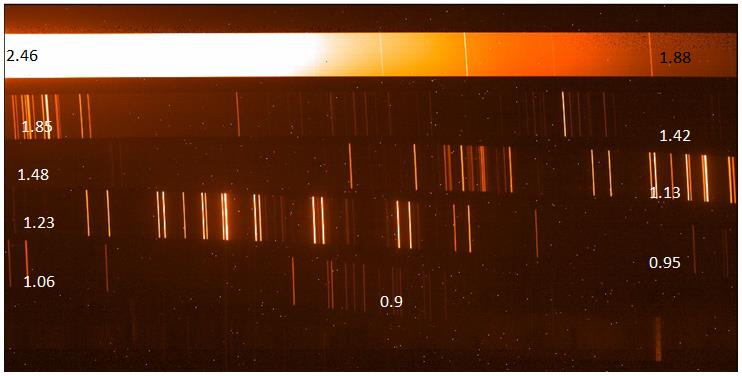The Instrument uses a fixed width slit, three prisms to cross disperse the light into at least 5 orders across the science detector, and a mid resolution grating. In addition, the first fold mirror is mounted on a piezo tip-tilt stage (S-340) to minimize the effects of flexure (FCS).
Spectrograph schematics from Wilson et al. 2004
3D representation showing the tip-tilt mirror.
Slit
The instrument has a fixed slit of 0.55" width and 18" in length. It is made of a reflective material.
In early 2018 we detected an imperfection in the slit. The effect of this imperfection is to show a trace on the dome flats. The follwing drawing (all dimensions are in units of arcseconds) shows the position of the imperfection (shown as a triangle). If possible, we suggest to avoid the compromised section of the slit.

Prisms
Two first two prisms are made of ZnSe with a 22 degree apex. The third prism is made of Infrasil with 50 degrees apex.
Grating
| Grating Name |
Grooves [l mm-1] |
Sampling [pix per resolution element] |
Blaze Wavelength [micron] |
Blaze Angle [degree] |
Spectral Resolution |
Peak Efficiency within each order | Notes |
|---|---|---|---|---|---|---|---|
| 110 | 110 | 2.7 | 6.98130 | 22 | 2700 See plot below |
55% at 825nm, 52% at 930nm, 55% at 1100nm, 60% at 1350nm, and 79% at 1725nm. | made by Newport |
Spectral resolution as a function of wavelength and order for a 0.55 arcsec slit.
Final Spectrum
The dispersed light is focused by a 7-element camera onto the detector. The following is a 700 seconds exposure obtained at CIT. The spectrum shows five cross-dispersed orders that almost (small gap from 1.85 to 1.88 microns) continously cover the near-IR spectrum from the Y band (order 7 at the bottom) to the K band (order 3 at the top).

NIRES spectra |
Plot of the cross dispersed orders (Wilson et al. 2004). |
| Go To: | ||||
| Instruments Home Page | Keck Home Page | Observer's Reference Shelf | ||
Send questions or comments to:NIRES Support